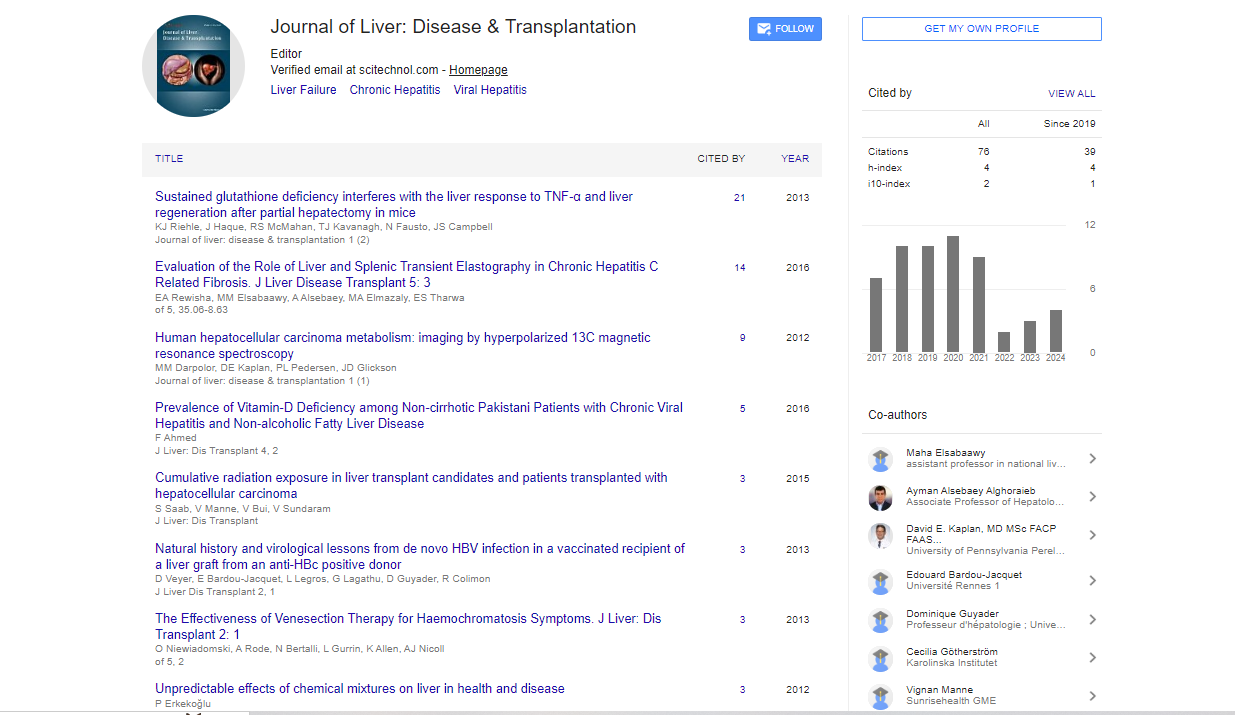Commentary, J Liver Disease Transplant Vol: 13 Issue: 3
Evaluating the Efficacy and Safety of Regenerative Medicine in Liver Disease Treatment
Olivia Bennett*
1Department of Hepatology, University of California, San Francisco, United States of America
*Corresponding Author: Olivia Bennett,
Department of Hepatology, University
of California, San Francisco, United States of America
E-mail: olivia.bennett@ucsf.edu
Received date: 26 August, 2024, Manuscript No. JLDT-24-151927;
Editor assigned date: 28 August, 2024, PreQC No. JLDT-24-151927 (PQ);
Reviewed date: 11 September, 2024, QC No. JLDT-24-151927;
Revised date: 18 September, 2024, Manuscript No. JLDT-24-151927 (R);
Published date: 25 September, 2024, DOI: 10.4172/2325-9612.1000280
Citation: Bennett O (2024) Evaluating the Efficacy and Safety of Regenerative Medicine in Liver Disease Treatment. J Liver Disease Transplant 13:3.
Description
Liver diseases represent a significant global health burden, affecting millions of individuals worldwide. Chronic liver diseases, such as cirrhosis, hepatitis and fatty liver disease, can lead to end-stage liver failure, necessitating liver transplantation for survival. However, the shortage of donor livers, coupled with the risks and complications associated with transplantation, has prompted study into alternative treatment modalities. Regenerative medicine refers to the process of repairing or replacing damaged tissues and organs using various techniques, such as stem cell therapy, gene therapy and tissue engineering and cell-based therapies. In the context of liver disease, regenerative medicine aims to regenerate damaged liver tissue, restore liver function and potentially reverse the progression of liver failure. The liver’s remarkable regenerative capacity makes it an ideal candidate for regenerative interventions. However, the complex structure and function of the liver pose significant challenges in applying regenerative medicine effectively.
Stem cell therapy is one of the most widely studied regenerative medicine method in liver disease treatment. Stem cells have the ability to differentiate into various cell types, including hepatocytes (liver cells) and can potentially restore liver function in patients with damaged livers. Several types of stem cells, including Embryonic Stem Cells (ESCs), induced Pluripotent Stem Cells (iPSCs) and adult stem cells, have been investigated for their potential to regenerate liver tissue. The use of stem cells in liver disease has shown promising preclinical results. In animal models, stem cells have been demonstrated to improve liver function, reduce liver fibrosis and promote tissue repair. Clinical studies involving stem cell therapy in humans have also shown some success, particularly in patients with cirrhosis or acute liver failure. However, while these results are promising, challenges remain in translating stem cell therapy into a widely accepted clinical treatment. One of the primary concerns is the limited availability of suitable stem cell sources, as well as the risk of immune rejection, especially when using non-autologous (donorderived) stem cells. Additionally, the optimal methods for stem cell delivery, dosage and long-term safety require further investigation. Gene therapy is another regenerative medicine technique that has shown potential in treating liver diseases. This method involves the delivery of therapeutic genes to the liver to correct genetic defects, promote tissue regeneration, or stimulate the liver’s natural healing processes. For example, gene editing tools such as CRISPR/Cas9 have been investigated for their ability to correct genetic mutations that lead to liver diseases such as hereditary hemochromatosis or Wilson’s disease.
Gene therapy has also been studied as a means to enhance liver regeneration following injury. One promising strategy involves the delivery of genes that promote hepatocyte proliferation, such as the Hepatocyte Growth Factor (HGF) gene. Studies have shown that the administration of HGF can enhance liver regeneration in animal models and has the potential to improve outcomes in patients with acute liver failure or cirrhosis. Despite the exciting potential of gene therapy, several hurdles remain. The challenge of efficient and targeted gene delivery to the liver, particularly in patients with compromised liver function, is a significant barrier to widespread clinical application. Additionally, there are concerns about the longterm safety of gene therapy, including the risk of insertional mutagenesis and immune responses to viral vectors used for gene delivery. One of the most exciting advances in tissue engineering for liver disease treatment is the development of bioengineered liver constructs that can be used in vivo. These constructs have been shown to improve liver function and reduce liver injury in animal models. In some cases, engineered liver tissue has been used as a temporary solution for patients awaiting liver transplantation, providing a bridge to transplantation while supporting liver function. However, tissue engineering is still in its early stages and several challenges must be addressed before it can become a viable treatment option. The complexity of the liver’s structure and function makes it difficult to recreate fully functional liver tissue. Additionally, issues such as vascularization (the formation of blood vessels) and immune compatibility of engineered tissues need to be resolved to ensure their success in human patients.
Conclusion
Regenerative medicine is important for the treatment of liver diseases, offering the potential to restore liver function, reduce the need for liver transplantation and improve patient outcomes. Stem cell therapy, gene therapy and tissue engineering have all demonstrated potential in preclinical and early clinical studies. However, significant challenges remain in terms of safety, efficacy and scalability. Continued study and clinical trials are necessary to reduce these challenges and bring regenerative medicine to the frontline of liver disease treatment.
 Spanish
Spanish  Chinese
Chinese  Russian
Russian  German
German  French
French  Japanese
Japanese  Portuguese
Portuguese  Hindi
Hindi 